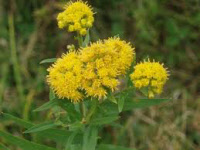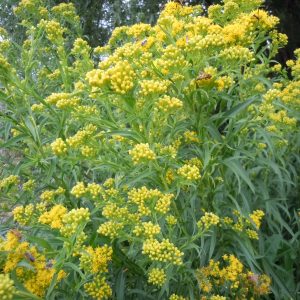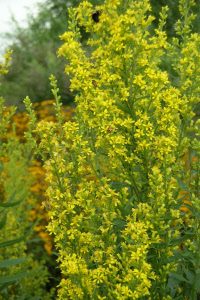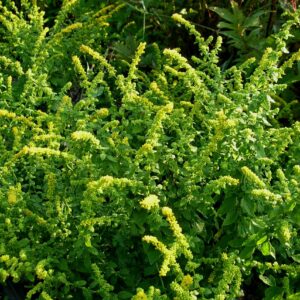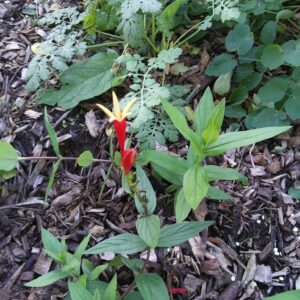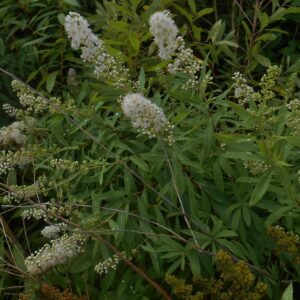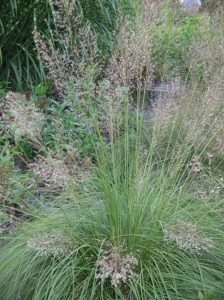Shop
Showing 697–704 of 788 results
-
Solidago graminifolia Grass-leaved goldenrod Z 3-9
Golden flat-topped inflorescences August to October, loved by butterflies for its nectar.
ARCHIVED
Note: This is a plant not currently for sale. This is an archive page preserved for informational use.
Golden flat-topped inflorescences August to October, loved by butterflies for its nectar.
Size: 2-3' x 1-2'
Care: sun in moist to moist well-drained soil, Deer resistant.
Native: Nova Scotia across Canada, S. to FL., Wisconsin native
Wildlife Value: loved by many butterflies for its nectar – Small copper, Monarch,Giant swallowtail, Gray hairstreak, Clouded Sulphur, Fritillary, Pearl crescent, & Cloudless sulphur. Attracts praying mantises; Deer resistant.The name Solidago from solidus and ago meaning to “bring together.” Gramnifolia means “grass-leaved.” Since 1750’s.
-
Solidago riddellii syn. Oligoneuron riddellii Riddell’s goldenrod, Stiff goldenrod Z 3-7
Sunshine yellow dome-topped flowers Sept.- Oct. Differs from S. gramnifolia by fewer leaves and its leaves fold toward the center vein.
Sunshine yellow dome-topped flowers Sept.- Oct. Differs from S. gramnifolia by fewer leaves and its leaves fold toward the center vein.
Size: 3’x2’
Care: sun in moist to moist well-drained soil.
Native: swath down middle of No. Am. From Hudson Bay to AK, incl. Wisconsin native
Wildlife Value: Loved by butterflies for its nectar – Small copper, Monarch, Giant swallowtail, Gray hairstreak, Clouded Sulphur, Fritillary, Pearl crescent, & Cloudless sulphur. Attracts praying mantises. Resists deer.The name Solidago from solidus and ago meaning to bring together. First published by German botanist Joseph Frank (1782-1835) who named it riddellii in honor of John Riddell who had collected it in Ohio before 1835.
-
Solidago speciosa Showy goldenrod Z 3-8
Broad spikes of erect panicles of mustard yellow welcome late summer into autumn
Broad spikes of erect panicles of mustard yellow welcome late summer into autumn
Size: 3-5’ x 12-18”
Care: Sun, any soil
Native: Central & eastern US, Wisconsin native
Wildlife Value: Loved by butterflies for its nectar – Small copper, Monarch, Giant swallowtail, Gray hairstreak, Clouded Sulfur, Fritillary, Pearl crescent & Cloudless sulfur. Attracts praying mantises.Meskwaki applied an infusion made of roots to burns. Chippewa used this plant for many things – to stop bleeding in the mouth and lungs, reduce pain from strains and sprains, as a stimulant and tonic and, mixed with bear grease, for a hair ointment. HoChunk and Winnebago made a blood purifier and remedied incontinence. Collected by Thomas Nuttall, English planthunter (1786-1859) who wandered over all of No. America searching for plants, animals, birds, and rocks from 1809 to 1842.
-
Solidago sphacelata ‘Golden Fleece’ Golden Fleece Goldenrod Z 4-8
Dense horizontal golden panicles on this dwarf Goldenrod, August to September
ARCHIVED
Note: This is a plant not currently for sale. This is an archive page preserved for informational use.
Dense horizontal golden panicles on this dwarf Goldenrod, August to September
Size: 12-18” x 24”
Care: full sun to part shade in moist well-drained to well-drained soil
Native: selection of species SE US
Wildlife Value: Butterfly magnet Monarch, Viceroy & Painted ladies
Awards: Winner Missouri Botanic Garden Award of Merit & Cornell University Allstar. Internationale Stauden-Union’s Award for outstanding new plant in Switzerland in 1994.Solidago from solidus and ago meaning to bring together. Species collected by 1800’s and named by Rafinesque but this short form was found in 1985 in Eden North Carolina. OK, it’s not really old (middle aged) but it is so different from all other Goldenrods that I couldn’t resist.
-
Spigelia marilandica Carolina pink, Woodland pinkroot Z 5-9
Stems topped with showy red tubes and fireworks-like yellow, five-pointed stars flare atop the tubes in late spring to early summer, later in the north. Deadhead for rebloom
Stems topped with showy red tubes and fireworks-like yellow, five-pointed stars flare atop the tubes in late spring to early summer, later in the north. Deadhead for rebloom
Size: 12-24” x 6-18”
Care: part to full shade in moist to moist well-drained soil
Native: NJ to Fl west to TX
Wildlife Value: nectar for hummingbirds; deer resistant
Awards: Pennsylvania Horticultural Society Gold Medal 2023Cherokee used this to purge parasites from intestines. In garden by 1753. Philip Miller’s Dictionary “the plant “is esteemed as the best medicine (in North America) yet known for the worms.” (1768) According to Jacob Bigelow in American Medical Botany, 1817 one doctor used it as a purgative and another as a narcotic.
-
Spiraea alba Meadowsweet, Du Roi Z 3-7
This short shrub sports white flower spikes 4” long blooming from June to August, deadhead for rebloom.
This short shrub sports white flower spikes 4” long, blooming from June to August, deadhead for rebloom.
Size: 3-4’ x 3-4’
Care: sun to part shade in moist to moist well-drained soil
Native: Northeastern 2/3 of North America, Wisconsin native
Wildlife Value: nectar attracts butterflies & hosts caterpillars of Spring azure butterfliesAlgonquin made a medicinal tea with Meadowsweet’s leaves and stems. Iroquois administered a decoction of mashed and powdered dry roots to remedy pain in the sides. 1st described in literature in 1772
**LISTED AS OUT OF STOCK BECAUSE WE DO NOT SHIP THIS ITEM. IT IS AVAILABLE FOR PURCHASE AT OUR RETAIL LOCATION.
-
Sporobolus heterolepsis Prairie dropseed Zone 3 – 9
Mound of graceful thinnest of grass blades
The description in the Chiltern Seeds catalog cannot be improved: “This is the most elegant and refined of the North American prairie grasses …the finest texture composed of the thinnest of thin, thread-like, glossy green blades,.. in autumn turning deep orange before fading to a light copper for the winter. In late summer the plants bear, on very slender stalks high above the foliage, unbelievably delicate, graceful flower panicles, excellent for cutting. ”One of internationally known garden designer Piet Oudolf’s 100 “MUST HAVE” plants, Gardens Illustrated 94 (2013)
Size: 2’ x 2’
Care: Full sun in well-drained soil
Native: from Canada in the north to Texas in the south, Wisconsin native
Wildlife Value: seeds are food for birds
Awards: Missouri Botanic Garden Plant of Merit & Great Plants for Great Plains Grass of the Year.Sporobolos is Greek from sporo meaning seed and ballein meaning to cast forth because the seed readily falls from the flower (or dropseed, the common name). Ojibwa “Medicine Society” used roots to cure sores & “remove bile.”
-
Stachys byzantina Lamb’s ears, Woolly betony, Wooly woundwort Z 4-8
Pale pink-lavender flowers on silver-gray spikes in summer with foliage as soft as a lamb’s ear.
Pale pink-lavender flowers on silver-gray spikes in summer with foliage as soft as a lamb’s ear.
Size: 12 x 12 spreading
Care: Full sun in moist well-drained to well-drained soil, low fertility
Native: Iran
Wildlife Value: Drought tolerant & deer resistant.Stachys is an old greek word meaning, “spike.” Stachys was believed to cure almost everything. Italians urged people to: “sell your coat and buy betony.” The common name “woundwort” describes the leaves’ function as bandages. Cultivated by George Washington at Mount Vernon.

